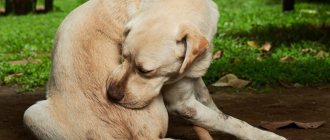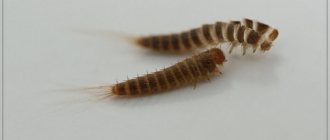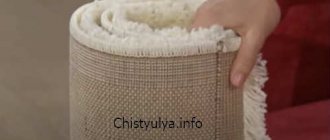Repellent odors
Smells that cause disgust in dogs can be divided into several categories. These include natural scents, artificial scents and special repellents designed to keep dogs away from restricted areas. Let's talk about each of the categories in more detail.
Natural smells
Natural odors include the odors of fruits, vegetables and plants, which do not require complex manipulations to obtain. In most cases, it is enough to place strong-smelling objects around the desired location to achieve the effect.
Natural odors have a gentler effect on your pet’s sense of smell, unlike chemicals.
Pepper
Pepper is a universal “repellent” due to the intensity of the aroma it emits. Both the negative and positive sides of pepper converge in the effectiveness of this product. Its aggressive influence on the olfactory system imposes certain prohibitions on its use: it is undesirable to resort to it when training puppies or hunting breeds that have a more sensitive sense of smell.
Pepper repels dogs both in its original form and in powder form.
Cayenne pepper scattered around the perimeter of the flowerbed will scare away domestic and stray dogs from it and ensure the safety of the plants. The dose of the product is determined by the size of the treated area. The main disadvantage of this method of dealing with uninvited guests is the need to re-treat the area after each rain.
Pepper can also be used in the form of a crushed pod, wrapping the product particles in gauze and spreading it around the house or around the dacha area. Shoes rubbed with such a pod discourage the puppy's interest in them after the first acquaintance.
You can rub a decoction of pepper on plants and objects without worrying about them spoiling.
Treating plants with a decoction with the addition of pepper will be effective. To prepare such a decoction, just dissolve one teaspoon of red pepper in a glass of water and boil the resulting liquid.
Makhorka
This type of tobacco may be known to many thanks to movies in which criminals hid their tracks using shag. On animals, shag produces a negative effect, prompting them to move away from the territory it has marked. Finding shag can be not so easy, so tobacco from ordinary cigarettes may be suitable as an analogue.
Thanks to its pungent odor, shag repels any animals with sensitive noses.
Shag can be used in dry form - just sprinkle it on an object or area that is forbidden to the dog. It is also possible to brew this type of tobacco and, if desired, mix it with other caustic ingredients (such as ground pepper) to enhance the effect.
Citrus
The smell emitted by citrus fruits is the worst enemy of both cats and dogs. You can use citrus fruits in any way: by laying out orange slices or orange zest, or by rubbing the fruit on surfaces that dogs cannot access. It is worth keeping in mind that hostility to citrus fruits is individual in nature.
Grapefruit peel is a real olfactory bomb in the fight against animal curiosity
The most aggressive fruit is grapefruit; oranges and tangerines have less impact on animals and may even attract them. The most effective is citrus essential oil, which can be purchased at any pharmacy and soaked into surfaces.
Hellebore
This remedy is little known in wide circles, but its alternative name “volkogon” speaks for itself. Hellebore does not grow in all regions of Russia and is currently popular in the taiga. A few stems of this plant are enough to discourage a dog from the forbidden area once and for all.
Due to the toxicity of this plant, it must be used with knowledge of the possible consequences.
The main disadvantages of hellebore are the difficulty in acquiring the plant and its toxicity. Unlike citrus fruits, shag and pepper, hellebore is fraught with real danger and can be fatal if ingested by a pet.
Large predator
Of course, supplying a garden flowerbed with bears to scare away dogs would be a completely pointless undertaking. However, formally, it is the smell of predators that gives an unambiguous command to the dog to retreat and hide in a safe place.
Animals smell the scents of their relatives over long distances and avoid encounters with strong individuals.
Probably, in the not so distant future, the odors of large and dangerous predators will be successfully synthesized and will fit into a compact bottle. In this case, this particular scent will be one of the most effective.
Artificial smells
All artificially synthesized odors, one way or another, produce a depressing impression on animals, forcing them to stay away from the source of the aroma. You can verify this by spraying deodorant near the animal and observing its reaction. Most likely, the dog will wrinkle and run to another corner.
Any sprayed substances cause dogs to want to move away from the source of the smell.
What can we say about more aggressive chemicals such as acetone or calcium carbide. Chemical odors should be used with extreme caution so as not to burn the animal’s sinuses or cause an acute attack of allergies.
Calcium carbide
If desired, calcium carbide can be purchased; it is sold in kilograms. However, one can hardly find the use of this compound in everyday life. It is not poisonous, but it emits a noticeable aroma in any condition. The smell intensifies when water comes into contact with calcium carbide, becoming unpleasant not only for the animal, but also for humans.
Calcium carbide is practically not used at home because it can be harmful
Moreover, this substance tends to release alkali, which is harmful to both plants and floor coverings. It is unacceptable to leave calcium carbide in the presence of children, as it can cause skin irritation if handled carelessly.
Perfumery
Smells that please people often cause sharp rejection in pets. This is partly due to the alcohol found in most perfumes and antiperspirants, which dogs can barely tolerate. However, there are individuals that demonstrate striking indifference to both fragrances and alcohol base.
Despite the fact that perfumes have a rich aroma, dogs' reaction to them varies from person to person.
In addition to an unpredictable reaction to perfume, it is also possible for your pet to become accustomed to certain, even strong odors. Addiction occurs faster if the aroma of perfume is filled with positive associations with the owner. As an aside, it should be noted that many dogs are intolerant of mouthwash.
Volatile organic compounds
Dogs do not perceive odors well:
- Gasoline;
- Household chemicals;
- Solvents;
- Essential oils;
- Varnish;
- Vinegar.
Dogs share a dislike for volatile organic compounds with humans.
It is these substances that ideally fall into the VOC category. You can often notice a negative attitude of a dog towards a tipsy owner who is trying to pet the animal, sometimes even turning into aggression. It's all because of the smell of alcohol, which seems unbearable to the dog. The combination of an unpleasant odor and a beloved owner causes internal dissonance and causes the animal to experience double stress.
It is unlikely that any owner would dare to use gasoline or solvents at home, since the aromas from these products are harmful to all living beings, without exception. But vinegar or pure alcohol can be very useful in the fight against an intractable dog without causing poisoning or burns.
Alcohol is the least toxic volatile compound, but its duration of action is short
It is enough to moisten a cotton wool or swab in the chosen liquid and place it in the right place to shock the dog’s sense of smell. The only weak point of such products is their rapid evaporation. In this case, mothballs, which have a persistent aroma, can come to the rescue - a pleasant bonus of using them will be getting rid of moths along the way.
Video - Smells that turn off dogs
Other repellents
In addition to exposure to odors, there are other methods of repelling dogs. In addition to the sense of smell, you can also influence the animal’s hearing through ultrasound, or even taste buds, which are very sensitive to unpleasant tastes.
For ultrasound to be effective, its frequency must be at least 21 kHz
Since the need to get rid of the dog’s annoying attention arises in different circumstances, the methods of dealing with animals should be different. We will talk further about alternative ways to scare off a dog and prohibit it from certain actions.
Table 1. Dog repellents
| Grannick's Bitter Apple Spray | The composition of the spray is completely safe for dogs even if ingested. Bitters, water and twenty percent isopropyl alcohol make the spray effective in combating dogs' excessive attention to forbidden objects. To use this substance, just apply it to an object. Non-aggressive components allow the composition to be applied not only to shoes, but also to other more delicate surfaces. Some owners even apply it to their hands if necessary. Disadvantages include quick odor dissipation and ineffectiveness when used outdoors. |
| HALT Dog Repellent Spray | This drug is suitable primarily for cyclists who are tired of the intrusive attention of dogs. The main component of the spray is capsaicin, which is extracted from peppers and has a sharp effect on the dog’s sense of smell. Since the composition is used in emergency situations, it must be directed directly at the four-legged pest to cause a quick reaction. When particles of the substance enter the dog’s nasal mucosa or oral cavity, the effect is achieved immediately. When spraying a substance, care must be taken to ensure that the person himself does not come into contact with the released stream. |
| The Company of Animals Pet Corrector | This product is not widely used in household conditions, since its influence extends to the dog’s hearing. When you press the cap, a compressed gas is released from the cylinder, which in itself is completely neutral. The effect is exerted by the sound itself with which the gas is emitted. Remotely, this sound resembles the hiss of a goose or snake before an attack and informs the dog that danger is nearby. Most often, this drug is used when training a grumpy pet to discipline it. This method of control is not very effective against wild or aggressive dogs. |
| Hoont Electronic Ultrasonic Handheld Dog Repellent | This device works using ultrasound, which is unrecognizable to humans, but has a negative effect on dogs. The product helps to instantly distract the dog from an unwanted action, but does not consolidate the result, since the dog does not associate ultrasound with a specific offense. Therefore, the device is more suitable for attracting individual attention. The device is completely safe and operates at a distance of up to 15 meters. Individual reactions to ultrasound should be taken into account - not all animals are sensitive to it. Some buyers noted the uselessness of the device, while others were satisfied with it |
| Havahart Critter Ridder 3146 Animal Repellent | The repellent is intended for treating soil that the owner plans to protect from attacks by pets or stray animals. The mixture contains natural ingredients: pepper and capsaicin. The product is great not only for fighting dogs, but also cats, squirrels and other animals. Its advantage over ordinary ground pepper is its durability - the particles of the mixture continue to affect the pet’s sense of smell even after rain and do not require renewal for a whole month. However, plot owners have repeatedly noted the dubious effectiveness of the repellent and the frequent ignoring of it by pets when mastering the beds |
| Orbit 62100 Yard Enforcer Motion Activated Sprinkler | The device is an automatic sprinkler with a built-in sensor that responds to the approach of animals. The device is equipped with night and day modes, allowing you to protect the area from encroachment around the clock. By taking into account the consumed liquid and battery, the sprinkler prevents the consumption of unnecessary resources and operates in an economical mode. According to reviews from site owners, this miracle of technology is the most effective in the fight against uninvited guests. |
If desired, you can combine several repellers to achieve the optimal effect depending on their scope of application. Thus, repellents scattered over the beds turn out to be completely useless when meeting stray dogs on the street, which ultrasound will help scare off, and vice versa. Below we will tell you how to choose an ultrasonic repeller so that the device turns out to be the most effective.
Choosing an ultrasonic repeller
Why do you need a dog repeller?
Fear is a basic emotion for survival. By acting on it, you can scare away the animal for a long time. Then the dog will stop attacking aggressively, shitting in unnecessary places, damaging property and destroying landscaping.
You can influence the animal's vision, hearing, smell or taste. Depending on this, repellent devices are divided into the following types:
Some odors common to humans are unpleasant to dogs.
Gas cartridges
Filled with a special mixture. When sprayed near an animal, they affect vision and smell.
Ultrasound
Affects the animal's hearing, is safe for people. There are portable and stationary repellers. You can carry mechanical (whistle) and electronic devices with you.
For your information! Stationary ones contain a motion sensor and turn on when a dog appears in the coverage area.
Portable ultrasonic repellers are compact and easy to use
Stun gun
They scare away animals using an electric discharge: sharp bright flashes of light, loud crackling, impact on pain centers.
Biological
They affect the dog’s sense of smell and have a pungent odor.
A few words about education
Before using repellents, the owner must be aware that this method of correcting the pet’s behavior does not lead to the consolidation of the desired type of behavior. If you are trying to stop your dog from marking corners or defecating in the house using strong-smelling substances, then most likely you will not succeed.
No repellents will help in raising a dog if the owner himself does not use it.
Remember that sudden impact on the animal's olfactory system will cause stress, especially if such impact becomes a habit. Stress, in turn, will lead to other behavioral deviations, which will also have to be dealt with somehow.
The most important means of influencing a pet is the authority of the owner. It is on this that all further educational measures are based. As you can see, spraying odorous compounds does not give a predictable reaction from the dog and does not allow you to achieve a clear result. Therefore, the repellent can be used as an aid, but nothing more. It is effective as a method of dealing with unfamiliar animals, but is useless as an educational measure.
Education and training of a pet are the key to its good behavior and devotion to its owner.
Conclusion
Most adults can easily identify these foods without even looking at them, especially if they are familiar with them. If it smells strong to you, it will be almost unbearable for your puppy.
Never use cosmetics as a deterrent. If you plan to use them on yourself, keep your dog in a well-ventilated area that will not be exposed to fumes. You can also buy natural beauty products or those that don't contain harsh chemicals.
Dogs are very sensitive creatures and can smell smells that you can't even smell. Every dog is different, so your puppy's reaction may differ from others. Over time, you will learn what your dog likes and doesn't like.
Understanding unwanted behavior
If you are unsuccessfully struggling with a dog because of its inability to relieve itself in an appropriate place, then it makes sense to think about the reasons for such actions on the part of the pet. Sometimes the reasons why a dog cannot tolerate going outside go much further than basic harmfulness or stubbornness. Other motives for this behavior include:
- Pathologies of the genitourinary system.
Whether it's cold kidneys or a urinary tract infection, your dog may experience an urge to urinate too often, making it impossible for him to wait until his next walk; Sometimes animals cannot control bladder emptying due to organ pathologies - Urinary incontinence. This ailment may not even be associated with any diseases and occurs due to prolonged stress, due to organs that have not had time to recover after castration, or due to the structural features of the sphincter. Some breeds with weak sphincters are prone to uncontrollable urination, which no repellent can do anything about. You can read more about urinary incontinence and ways to combat this disease on our portal;
- Lack of daily routine.
Sometimes the owner himself may be the cause of untimely urination. Dogs that are accustomed to eating and walking at certain hours, as a rule, maintain the routine themselves and do not try to break it. Cleanliness is inherent in these animals. However, in the absence of a day plan, the dog may simply not calculate its physical capabilities; Lack of discipline encourages your pet to go to the toilet whenever he pleases - Reaction to inappropriate behavior of the owner.
If you allow yourself to be excessively aggressive when interacting with your pet, then you should not expect ideal behavior from him. Dogs cannot speak, but they can communicate their mood to us through their actions. Urination can be an expression of protest against mistreatment and an attempt to stop the “lawlessness” on the part of the owner. In such a situation, continuing the war with the help of strong odors will only lead to a deterioration in relations; The key to a pet’s diligent behavior is strong friendship with the owner and trust in him. - Pay attention. All pets need the attention of their owner. If you show indifference to your dog, then in an attempt to remind you of yourself, he may do the most unexpected things. There are frequent cases of uncontrolled urination when changing the usual living conditions. Getting a new pet, moving, and other circumstances can also cause unpredictable changes in behavior.
If you have problems with your dog relieving its needs in the apartment, of course, they need to be addressed. There are many means that are used to prevent animals from shitting anywhere. But where to start depends, first of all, on the age of the dog. How to stop her from peeing and is it worth using a scent that repels dogs if she is still a puppy? Toilet training (tray, disposable diaper, etc.) is one of the main points in raising a little four-legged friend.
Advice There are, of course, small breed dogs that are accustomed to going to a special home toilet. However, the vast majority of adult dogs do this outdoors.
It’s a completely different matter if your dog is no longer a puppy, but still craps in the apartment.
How to toilet train a puppy?
If the dog is still small, then, in general, there is no problem. Your pet will learn to go outside during the first year of life.
Important Puppies do not know how to endure and therefore “go” where they have time. It cannot be any other way. Scolding a puppy can only make things worse. However, you can teach your baby to use the toilet, which is discussed below.
To protect your apartment from the smell of dog urine and feces, it is advisable to allocate a small space on the flooring that is easy to clean as a toilet. You can also cover an area of the floor with an absorbent blanket. The most important rule is to try not to punish the dog for “bad” behavior, but also don’t particularly praise it for “good” behavior, even if it was done in a designated area, since, in the long term, the dog should get used to the street. As a rule, before the first vaccinations, the puppy cannot be taken for walks, which is why he is temporarily taught to use the toilet indoors.
Use newspapers and special diapers for dogs. You should bring the puppy to them as often as possible: when he has eaten, he just woke up when you saw that he began to sniff the floor or spin around in place. Praise for “correct” urination. Yelling at a dog if it has already committed a “bad” action is unacceptable; it will not understand what its fault is. Aggression can only frighten the puppy; he will simply begin to be afraid and avoid his owner.
Tip If you see that the baby is starting to try on the “pee-pee”, throw the keys on the floor or hit your hands so that he is distracted, and then pick him up and immediately take him to the diaper or outside. In your hands, the dog will try to be the most restrained, and if you lead him on a leash, he can leave a “gift” right on the staircase.
Why does an adult dog shit in the house?
To cope with a similar problem that manifests itself in an adult pet, you will have to work hard on it. To retrain such a dog, in addition to auxiliary means and smells that repel dogs, you will need a lot of patience and perseverance, as well as intensive training.
Before taking any action against animals, Miss Clean magazine recommends determining the reason why they began to behave this way. You may need to consult your veterinarian.
- Diseases of the genitourinary system are characterized by a frequent urge to urinate; a dog in such a situation simply cannot wait to go for a walk.
- Incontinence caused by old age or illness. A sick pet should never be scolded. For a dog, the fact that he gets dirty in the house is already stressful. Be sure to show your pet to the veterinarian, buy dog diapers or nappies.
- At one time, the animal did not develop a feeding and walking regime. To eliminate the problem, your pet should be provided with regular meals and walks.
- An owner who once shows aggression towards a dog may lose authority in front of it. She may start to shit even when he starts talking to her loudly.
- A dog can also write out of boredom, that is, when no one is playing with him, showing in such a simple way that he needs more attention. This could be a kind of protest, for example, if another pet appeared in the house or even a child who was given more attention.
Interesting fact Normally, a dog not only relieves itself on the street, but is also jealous of cleanliness in the house. Owners who have a dog and a cat may have noticed that the dog often cleans up after a “rowdy” cat. This is how the dog takes care of cleanliness and protects his furry friend from the righteous anger of his owners.
No. 4. Fresh herbs
Many dogs don't like fresh herbs like mint or rosemary. They have a very pungent aroma that they don't like. You can use this fact to your advantage and plan for fresh herbs in your garden.
Not only will it keep your dog away from other plants, but you'll always have a fresh supply on hand. Alternatively, you can also create a simple spray solution by soaking the herb in water to extract the oils from it.
While most dogs cannot tolerate grass, some will have no problem with mint. In fact, there are many mint-flavored treats that can help combat bad breath. Before you start purchasing mint products, see how your dog reacts to the smell and taste.
How to stop a dog from crapping using repellent odors
Nowadays, many veterinary pharmacies and pet stores have a large assortment of special medications that can be used as an aid to stop a dog from shitting in the wrong place, for example, on the carpet. These products are quite effective, you just need to spray all the places where your pet is addicted to doing this.
The smell will scare the dog away the next time it is about to do an unacceptable act. These products are successfully used not only in apartments, but also in summer cottages; they help preserve garden beds and lawns.
Very often young dogs on a walk do not understand where they can go to relieve themselves and where not. Unfortunately, the animal is not aware of the presence of beds, lawns, and front gardens. The best solution would be to spread repellent odors in areas where the pet is not allowed to walk. However, many chemicals quickly evaporate or completely pollute the soil. Therefore, the site mschistota.ru recommends preparing such a remedy yourself from available ingredients, especially since there is nothing simpler. It can be created using alcohol, vinegar, shag, citrus fruits, or even hot pepper—there are still many household smells that repel dogs.
Alcohol
The smell of rubbing alcohol lingers for a long time, and dogs cannot stand it. Therefore, if she smells a similar aroma, she will try to avoid these places for a long time. Place swabs soaked in alcohol around the garden. In an apartment, it is enough to wipe the floor with water with the addition of a small amount of alcohol.
Hot peppers
Hot pepper is also able to protect the garden from pet attacks. A decoction of hot pepper irritates the mucous membranes, so dogs will avoid contact with this product. Spray the leaves of plants, beds with it, or, for example, wash the entrance with it if the animal has taken a fancy to it.
Vinegar
Vinegar essence is also an excellent repellent for dogs. Dampen rags with this solution and place them in “hot” areas. The effect will not be long in coming - the dog is unlikely to want to be there, much less pee.
Citrus
The smell of citrus fruits is more suitable for indoors, as it disappears faster, and it would be irrational to spread the remains of oranges and lemons all over the area. You will have to lubricate the surfaces with citrus juice every day, but in the end, the dog will remember where the source of the repellent odor is and will understand what they want from it.
Baking soda
Sprinkle baking soda over the entire surface of the lawn. You can also use a soda solution and pour it over the area where the dog managed to mark the territory. It is unlikely that she will return there with bad intentions. In addition, baking soda protects plants from other diseases or insects. It neutralizes the smell of urine and scares away other dogs.
How to use "aromatherapy"
Before using aromatic substances in any form, you must thoroughly clean the surface without using detergents, since soaps and cleaning powders contain fragrances and can kill the odor used to repel dogs.
How to stop a dog from crapping using repellent odors
When using natural scents, it is enough to place fragrant plants in the places that the dog has chosen.
Synthetic fragrances are dissolved in water in small quantities. This solution is applied to the surfaces of furniture, poured onto the lawn, or washed on the floor. The main thing is not to overdo it with the amount of substance, otherwise there is a risk of burning your pet’s sinuses.
Store-bought products are usually available in the form of sprays. It is enough to spray the contents of the can on the selected area from a distance of 30 cm.
It is necessary to renew repellents for dogs to prevent them from pooping every day until the dog learns that he needs to relieve himself in another place.
How to scare dogs away: effective methods
It is most effective to influence the behavior of a pet through the authority of the owner. If the dog was raised correctly from an early age, he will listen and follow commands.
When it comes to other people's dogs, everything is much more complicated. But there are still several techniques that can scare away unfamiliar dogs from your territory. Here are some tips:
- fence the area with a high fence and string barbed wire along the bottom;
- train your own dog (if you have one) to bark at the sight of strangers;
- use repellent scents by watering the area with them or placing moistened cotton swabs around the perimeter;
- install a stationary ultrasonic emitter;
- install an automatic water sprinkler;
- call the dog catching service (if the dog is homeless).
Important! You should not feed unfamiliar animals on your territory, otherwise they will come often.
How to stop dogs from pooping on your lawn
If the situation repeats itself over and over again, you need to understand the reasons why the dog chose this particular place. The dog may have health problems or a stressful situation. Then you should immediately contact your veterinarian. When the reason is different, you need to try to correct the animal’s habits through educational measures.
If unsuccessful, the question arises: how to scare the dog away so that it does not shit on the lawn. You can plant plants with a strong aroma (jasmine or lavender) in this area. Hellebore also effectively affects a dog's sense of smell, but it is poisonous and can pose a real threat not only to animals.
There are special signs on public lawns indicating that dogs are prohibited.
An automatic watering system with water spraying will also help scare away uninvited guests. If you install motion sensors, watering will turn on when a potential pest enters the area of influence. But at the same time, water costs will increase significantly, and there is a risk of flooding the area.
How to scare away from the garden
Most dogs are trained to pee and walk around outside. But they do not distinguish where exactly they can relieve themselves, and where the owner grows his crops. First, you should patiently explain to your pet the rules of behavior on the site and try to control his behavior: pet him and praise him for obedience and not shout if he makes a mistake.
How to get rid of unwanted pets?
It often happens that other people’s pets come into the territory of owners who don’t even have a dog. Their marks can have a detrimental effect on lawns, carefully planted plants and shrubs. Moreover, as soon as one dog pees in the garden bed, the smell begins to attract a pack from all over the area. But you shouldn’t rush to give in to such invasions; there are many methods for dealing with “uninvited guests.” In this case, it is not the beds that need to be protected, but the entire garden plot.
Lavender or thorny bushes
Plant plants that do not have a pleasant scent for dogs, such as lavender. This way you will create a natural repellent barrier.
Fence
The best remedy for uninvited guests is, of course, a good fence. Of course, a dog looking for a secluded place will choose an unfenced area. Periodically check along the fence for any digs made by animals. Applying current to the fence is used only as a last resort - this can be dangerous not only for dogs or cats, but also for people.
Ultrasonic repeller
Alternatively, you can use a repeller with ultrasonic radiation. The device is installed near the location of the dog gathering. As the animal approaches, the motion sensor will be triggered and automatically release ultrasonic waves. Dogs are too sensitive to this range and will rush to leave your garden as quickly as possible.
Hot peppers
What smells scare dogs away so that they don’t come back for a long time? This may be the smell of hot pepper, elusive to the human nose, but intolerable to dogs!
Make a decoction with a small amount of chili pepper, put on gloves, and spray the leaves and grass in the garden. At home, use a weak concentrate, as the smell does not disappear for a long time and the dog may feel unwell.











